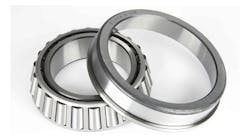Vibration dampening is a key element in heavy machinery maintenance. For example, a manufacturer of high-speed printing equipment for plastic containers and bottle caps was experiencing significant increases in the cost of the weldments used as a base for their equipment, which prints bottle caps with four colors in one pass at more than 600 pieces per minute. At the same time, competitive pressures required the operator continue to increase the speed of the machines. The equipment prints multicolored images on everything from bottle caps, to caulk tubes, plastic bottles and plastic pails. The operator also wanted to find a "green" alternative, if possible, which led to Castinite precision polymer cast (PPC) bases.
Production and delivery costs are only one concern for steel weldments used to dampen machine vibration; effectiveness is another.
The machines, shipped worldwide, are known for their speed and the quality of their printing. The machines had been mounted on steel weldments, typically measuring 2,300 X 2,300 mm X 200 mm (90.55 X 90.55 X 79 in) high. With steel prices escalating, the cost of the weldments had increased significantly and delivery times could stretch out to as much as 12 weeks. Also, the steel weldments need to be stress-relieved, machined, stress-relived again, and then painted to protect them against rust. (Rust is a concern depending on the plant conditions, including plants in high-humidity climates.)
Precision polymer castings
Castinite PPCs dampen vibration 45 times more effectively than steel, allowing machines to operate faster while maintaining print quality. Machines mounted on PPC bases operate much more quietly, making it easier to meet OHSA requirements for noise control.
Unlike steel weldments, Castinite PPCs do not need to be stress relieved so they save cost and improve delivery time. They can usually be cast to finished tolerances, eliminating costly machining. This lowers the finished-part cost and allows much quicker delivery. Delivery of a finished part can be days versus weeks, lowering inventory costs and making delivery planning much easier.
PPCs cannot rust or corrode and can be cast in color, eliminating the need to paint. Again, this lowers the finished-part cost and shortens delivery time. It also reduces air and water pollution associated with painting operations. The cost of a finished Castinite casting is only 45% of the cost of the weldment.
Energy savings
Polyvinyl castings used as bases to dampen machine vibration can be produced to acceptable flatness tolerances, eliminating the need for machining. Cast-in holes for hydraulic lines also save finishing costs.
The total production process for a polymer casting can save up to 80% of the energy typically used to produce the steel weldment. To produce steel or cast iron parts, ore is mined and smelted into pig iron, which is melted and mixed with various elements to produce steel ingots. The ingots are heated and rolled into steel shapes. Then, steel shapes are machined to size for producing the weldment. The steel components are then welded together and stress-relieved. After stress-relieving, they are machined to the final size and configuration, and holes are drilled and tapped. Once this is completed, the part can be painted. In the performance of these various operations the parts are usually trucked from location to location, consuming more energy and adding to the air pollution.
Cast iron follows a similar path: billets of iron is melted and poured into a mold. This rough casting must be machined, stress-relieved, and finished machined. A final stress-relief step may be necessary, along with a final finishing operation. Once machined, the part can be painted.
Castinite follows a much more efficient path. It consists of a liquid resin and natural aggregate filler. The liquid raw materials, which may include agricultural content, are mixed in a reactor. The aggregate, usually quartz, is surface mined, crushed, and sized.
Once a mold is produced, finished parts can be ready in a few days, complete with all the tapped holes and to very precise tolerances. The liquid mixture is poured into the mold and cures at room temperature. Because it is polymer and high-purity quartz, painting is not necessary. Parts can be cast in color, if that’s preferred. This means finished parts are ready in days, rather than weeks or months, reducing inventory costs.
The bases of these castings call for flatness of only 0.010 inch in the mounting area, which is easy to achieve with polymer, even in a wood mold. Castinite was able to achieve this tolerance using a mold made of composite materials for less than $2,000.
In addition to all these benefits, consumer-grade PVC pipes for wire ways were cast into the base, with outlets located exactly where they would be needed. This eliminated the external wire ways that were more expensive, easily damaged and required extra wire to reach the proper locations. PVC pipes also are used to run hydraulic lines through the base, lowering their cost and making them less susceptible to damage and producing a much cleaner machine.
With machined weldments, hole locations may be out of tolerance on any base due to a glitch in the motion of the milling machine, tool breakage, or due to a machine-programming mistake. With Castinite polymer castings, hole locations are fixed in the mold, so they will always be in exactly the same location for each finished product. They do not depend upon the drill and tap condition. Inspection of the holes and cast-in features is not necessary.






